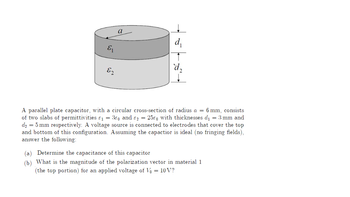Question

Transcribed Image Text:E₁
E2
a
d₂
A parallel plate capacitor, with a circular cross-section of radius a = 6 mm, consists
of two slabs of permittivities &₁ = 30 and 2 = 250 with thicknesses d₁ = 3 mm and
d₂ = 5 mm respectively. A voltage source is connected to electrodes that cover the top
and bottom of this configuration. Assuming the capactior is ideal (no fringing fields),
answer the following:
Determine the capacitance of this capacitor
(b) What is the magnitude of the polarization vector in material 1
(the top portion) for an applied voltage of Vo = 10V?
Expert Solution
This question has been solved!
Explore an expertly crafted, step-by-step solution for a thorough understanding of key concepts.
Step by stepSolved in 3 steps
